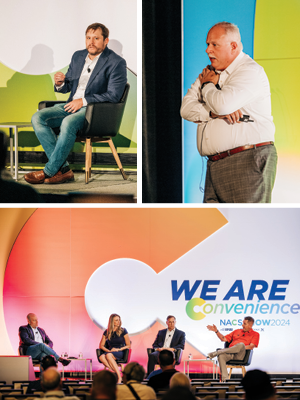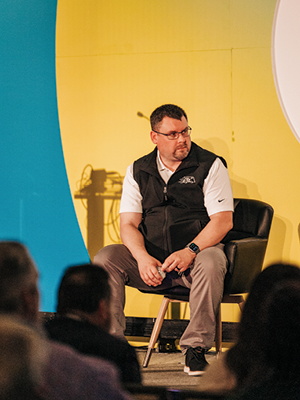The 2024 NACS Show had 50 Education Sessions, put together by retailers, for retailers. More than 100 industry leaders took the stage to share their insights with their peers.
Topics ranged from essential advice for category managers to creating a more restaurant-like menu to specific use cases for AI.
Here’s a sample of the conversations that took place at the Education Sessions. Want the full scoop? Recordings are available for purchase.
To Turn Around 2024’s Flat Sales, Focus on Foodservice
The retailers that Chris Rapanick, managing director of research at NACS, has spoken with so far this year have described business as “soft,” he said during “Breaking Down the Latest State of the Industry Data.” So most retailers won’t be surprised by the industry-wide numbers from the first half of the year, which are flat across many categories.
As of June, here’s how NACS’ State of the Industry data is shaking out for the first half of 2024 compared to the first six months of 2023:
- Average fuel price is down 7.8%, but fuel gallon sales are up 2.5%—the largest increase in years after being flat, according to Rapanick.
- Inside sales are down 1%.
- Total transactions are down 3.4%.
- Foodservice sales are up 3.9%, but Rapanick noted this is slowed growth compared to the category’s normal double-digit growth.
- Total store gross profit is down 1.8%.
- In-store gross profit is up 3.5%, though this is in line with current inflation numbers.
Merchandise shrink growth has accelerated 170% since July 2021 and retailers are also struggling to keep up with increasing direct store operating expenses (DSOE), which are up 5.3% total. The costs for some key categories that fall under wages and benefits have increased in the double digits.
But on the plus side, inflation has cooled significantly from last year, and the average basket size is also up to $8.98, an increase of 6.8%.
But how profitable is that $8.98 basket? Well, when you break it down and subtract the costs of goods and other operating expenses, the inside operating profit per transaction totals an 11 cent loss. “This is how much you’d be making if you didn’t sell fuel,” said Rapanick, noting that fuel sales are 67.1% of the average retailer’s business and 37.9% of gross profit so far this year.
 Industry leaders offered advice for women (and men) in “Women in Convenience: Navigating Leadership Paths and Driving Success.”
Industry leaders offered advice for women (and men) in “Women in Convenience: Navigating Leadership Paths and Driving Success.”
“On the plus side, this is only a few pennies,” said Rapanick. “If you can grab a couple cents on the cost of goods or on inside gross profit dollars, you can make a huge difference here.”
One of the major areas where retailers can make up some of this lost ground is by focusing on foodservice programs, which currently contribute 9% to overall sales and 19.5% to gross profit dollars.
“The only thing that is going to buoy the sales model is foodservice,” said Rapanick. “The five foodservice categories would all be one of the top 10 merchandise categories if they were merchandise, and they would be the top three out of five in terms of margin.”
Compared to the first half of 2023:
- Prepared food is up 5.4%
- Commissary is down 5.9%
- Hot dispensed beverages are down 5.7%
- Cold dispensed beverages are up 1.5%
- Frozen dispensed beverages are up 11.2%
“The reason commissary numbers are down is likely because a lot of people are moving away from the commissary business toward a much more made-to-order, custom-prepared food model,” Rapanick explained.
NACS uses a benchmarking tool that segments retailers into deciles based on performance, with the top 10% of retailers in the top decile and so on. Top decile firms outperform the next (ninth) decile by a factor of 1.5X, and outperform the bottom decile by a factor of 9.6X. However, all ten deciles are still profitable.
Only the top four out of 10 deciles were profitable when accounting only for inside store operating profit, with the bottom performing decile in the red $30,247 per store, per month.
The top decile brought in an average of $136,381 in foodservices sales, which was 5.5X higher than the bottom’s average of $24,868, and the top decile made 6.9X more in gross profit dollars.
And going back to the basket analysis showing that the average retailer lost 11 cents per basket … the firms in the top decile were making a profit of 32 cents per basket.
The 2025 NACS State of the Industry Summit takes place April 8-10 in Dallas, Texas. Learn more.
Advice From Female Industry Leaders
Four leading women in the c-store industry, Renee Bacon, senior vice president of sales and operations and chief merchandising officer at Murphy USA; Annie Gauthier, CFO/co-CEO of St. Romain Oil Company LLC; Jamie Miller, executive director of marketing and DEI champion at RaceTrac; and Danielle Holloway, senior director of industry engagement at Altria, shared advice for women (and men) in convenience during “Women in Convenience: Navigating Leadership Paths and Driving Success.”
Intentionality is key—in both work and personal life. Gauthier said that in leadership, she focuses on being “very intentional with my time, with my language. I ask a lot of questions. I want to not just learn from other people, but I want to help other people learn for themselves and from themselves and others.” In her day-to-day work, scheduling her time intentionally has been a high priority. This includes time with her team, time to develop herself professionally and time to set work aside and focus on family and friends.
Give yourself grace. Bacon shared that giving herself grace in her personal life, such as when she misses some things with family (never important events), keeps her from stressing too much and lets her get stuff done as needed. “When I started to give myself grace, and also started to let others around me know I needed help and to feel comfortable in being vulnerable, is when life got better.”
 John Eichberger led a panel that dove into the right fuel mix now and in the future.
John Eichberger led a panel that dove into the right fuel mix now and in the future.
Assume positive intent, even in a conflict. Miller shared that she’s learned that approaching things with curiosity and assuming other people have positive intent, even in conflict situations, “helps you build stronger trust in relationships, and then you can get more things done cross functionally.
Know what you stand for and what you want your legacy to be. “Early on in my career, I was challenged on what I want my legacy to be,” said Bacon. “And I came up with a motto of ‘Show up, work hard, be kind.’ … If I say I’m going to do it, we’re going to do it working hard. I’m going to work hard. I probably can outwork most people. And I would never ask people to do things I wouldn’t. And then finally, the part of being kind, truly caring about people [means that] you can challenge them directly.”
Similarly, know yourself. “Engage in one of those [personality or strengths] assessments, learn about yourself, learn language you can use, learn how to celebrate how you are and lean into those strengths with humility, which comes easily to most women, I think, and also with confidence,” Gauthier advised. “And then, once you know yourself, make intentional choices.”
Be your authentic self. “I spent years in my career being coached to be a different way,” said Miller. “I found I was most successful when I was actually who I am.”
Building or Remodeling a Store? Read This.
When it comes to designing a store that is convenient, easily accessible, modern and full of amenities, where do you start? Friendly Express, based out of Georgia, focuses heavily on making locations consumer focused.
When remodeling or working on a new build, Friendly Express prioritizes store parking and ease of access to parking, said Gabe Manning, director of operations. Friendly Express is currently working on a location that will have six different entrances into the parking lot.
“The location of foodservice also matters,” said Manning during “Learning From Your Peers: Common Pitfalls in Remodels and New Builds.” Some Family Express stores have full-size delis, and “the kitchen is right behind the register so workers can easily access both sides.”
In states like Georgia and Florida where hurricanes are a common occurrence, Friendly Express says that having a generator on hand is big. “Our flagship mini truck stop has a generator, and after a hurricane hits, we can still service the community. We did over $100,000 in cash-only sales each day after a hurricane. We had no Internet or cell service, but we got people in and out of the store,” Manning said. “We were able to service the first responders.”
It’s also important to consider what amenities your customers want in a store, including dog parks on highly traveled highways, an updated coffee bar or seating both inside and outside of the store, said Manning. Technology is a large part of this, too. Friendly Express added self-checkouts to its busiest locations and made the kiosks very visible in stores. The retailer also is in the process of integrating mobile ordering.
 Richard Cashion, Curby’s
Richard Cashion, Curby’s
Curby’s Express Market, based out of Lubbock, Texas, is currently in the process of building three new stores.
“There’s only so much disposable income in your area,” said Richard Cashion, COO of Curby’s. That means your site isn’t just competing against other c-stores, it’s competing against all retail. As an example of winning that competition, Curby’s has over 50 flavors of tea and bubblers available in its stores and has found financial success with this extensive offer. In fact, Curby’s considers itself a “QSR in a convenience store,” helping it to compete with other local QSRs.
“It’s important to create large, multipurpose stores,” said Cashion. “Drive-thru’s add convenience: 56% of our business is through that. Work with your designers and be sure you’re building out enough space. If you can think it, you can build it.”
Getting Your Fuel Mix Right
Transportation Energy Institute Executive Director John Eichberger kicked off “How to Determine Your Fuel Mix” by noting that politicians see electric vehicles as being an easy solution for carbon reduction, but this misses out on the realities of the vehicle fleet moving into the future. That means it’s critical to find and promote other solutions.
Helena Jette, director of market development and biofuels for the Indiana Soybean Alliance, Indiana Corn Marketing Council and Indiana Corn Growers Association, shared a perspective on the food-versus-fuels debate. The corn that is used for ethanol is “not the sweet corn you eat, it’s the field corn, which is mostly for livestock,” she said. “We grow corn and soybeans on less land every year, and production is through the roof. And the biofuel blends provide some amazing stats. You can reduce greenhouse gas emissions up to 50% by blending ethanol. And with biodiesel it’s about 80%.”
Jeff Dzierzanowski, manager of new business development for the equipment distributor Source North America, noted that only about 7% of convenience stores currently offer an ethanol blend above 10% (E10). That represents a huge opportunity to expand lower-carbon fuels.
“The easiest and most logical pathway is going to be E15,” said Dzierzanowski. “Vehicles built since 2001 are already compatible with that product. And when you build a site today, there are just a few tweaks that you would have to take and make. When we get into older legacy sites, it gets a little bit more challenging. But each year we get further and further away from those challenges.”
A retailer perspective was provided by Nate Hale, director of construction and facilities for Wally’s. “Our goal is to assist people in travel, no matter what that means—whether that is EVs or cleaner liquid fuels or hydrogen,” he said.
Hale noted that biofuel blends can make economic sense in addition to giving retailers the ability to tout the environmental aspects.
“Whether it’s in the pipeline or you buy it directly off the racks or you get it delivered to your store, you can obtain these fuels at much cheaper prices now than you could before,” Hale said. “You are able to pass that savings along to the consumer or split it to increase your profits.”
He noted that retailers may fear the uncertainty of making a switch. However, there is plenty of data and research, along with experienced equipment suppliers that can support the decision.